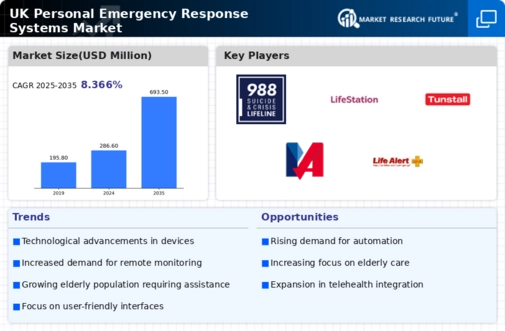The personal emergency-response-systems market is currently characterized by a dynamic competitive landscape, driven by technological advancements and an increasing demand for safety solutions among aging populations. Key players such as Philips Lifeline (US), Life Alert (US), and ADT Inc. (US) are strategically positioned to leverage innovation and partnerships to enhance their service offerings. Philips Lifeline (US) focuses on integrating advanced health monitoring technologies into its systems, while Life Alert (US) emphasizes rapid response capabilities and user-friendly interfaces. ADT Inc. (US) is expanding its portfolio through strategic acquisitions, thereby enhancing its market presence and operational capabilities. Collectively, these strategies contribute to a competitive environment that is increasingly focused on technological integration and customer-centric solutions.
In terms of business tactics, companies are increasingly localizing manufacturing and optimizing supply chains to enhance efficiency and reduce costs. The market appears moderately fragmented, with several key players exerting influence over specific segments. This fragmentation allows for niche players to thrive, while larger companies consolidate their positions through mergers and acquisitions, thereby shaping the overall market structure.
In October 2025, Philips Lifeline (US) announced a partnership with a leading telehealth provider to integrate remote health monitoring into its emergency response systems. This strategic move is likely to enhance the value proposition of their offerings, allowing users to receive comprehensive health insights alongside emergency assistance. Such integration may not only improve user experience but also position Philips Lifeline (US) as a leader in the convergence of health technology and emergency response.
In September 2025, Life Alert (US) launched a new mobile application designed to enhance user engagement and streamline emergency response processes. This application allows users to customize their emergency contacts and access real-time health data, which could significantly improve response times. The introduction of this technology suggests a shift towards more personalized emergency services, potentially setting a new standard in the industry.
In August 2025, ADT Inc. (US) completed the acquisition of a regional emergency response service provider, thereby expanding its operational footprint and service capabilities. This acquisition is indicative of a broader trend where larger firms seek to consolidate their market positions through strategic purchases, enhancing their ability to offer comprehensive solutions. Such actions may lead to increased competition as these companies strive to differentiate themselves through expanded service offerings.
As of November 2025, the competitive trends in the personal emergency-response-systems market are increasingly defined by digitalization, AI integration, and a focus on sustainability. Strategic alliances are becoming more prevalent, as companies recognize the value of collaboration in enhancing service delivery and technological capabilities. Looking ahead, competitive differentiation is likely to evolve from traditional price-based competition towards innovation, technology integration, and supply chain reliability, suggesting a transformative shift in how companies position themselves in the market.















Leave a Comment